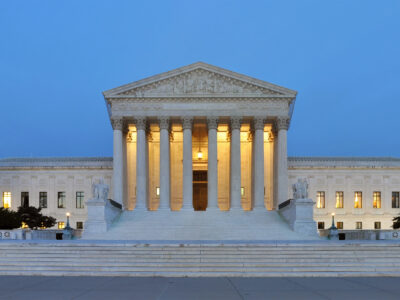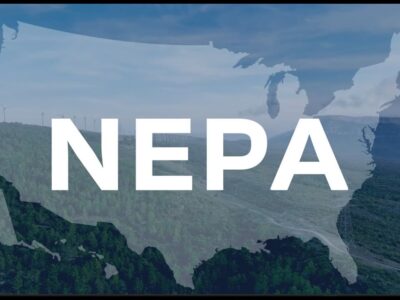The Outcome of the Seven Counties Case
Court emphasizes agency discretion and judicial deference in NEPA.
The Supreme Court issued its decision today in the Seven County NEPA case (available here). For background on the case, see our prior posts here, here, here, and here, as well as our article. In this post, we’ll provide a brief overview of the opinion. Next, we’ll undertake a brief analysis of the Court’s reasoning in our second post. After that, our final post will explore what we think the likely implications of the opinion are for NEPA compliance by feeral agencies going forward.
The short version of the opinion is that the petitioners (the railroad) won (most) of what they wanted. The Court reversed the D.C. Circuit on the NEPA questions at issue in the case. The result could be a significant reduction in the consideration of what are called “indirect effects” under NEPA by federal agencies – effects that are distant in time and space from the original action under review. Here, we want to highlight three key themes from the opinion.
First, in Part II.A., the Court emphasized the importance of deference by federal courts in reviewing agency NEPA review: “when determining whether an agency’s EIS complied with NEPA, a court should afford substantial deference to the agency,” slip op. at 9. That is in part, the Court stated, because NEPA “involves primarily issues of fact,” slip op. at 10. The Court specifically noted deference should be applied to the level of detail in an agency’s NEPA analysis, to its analysis of significant environmental impacts and feasible alternatives, and (most importantly for this case) to the scope of the environmental effects the NEPA review will address.
Scope is most important because the dispute in this case was over agency review of the “upstream” effects of constructing a railroad, in terms of the oil and gas production the railroad might facilitate, and the “downstream” effects, in terms of the emissions produced by the refining and combustion of the oil and gas carried by the railroad. The Court emphasized that:“courts should defer to agencies’ decisions about where to draw the line – including (i) how far to go in considering indirect environmental effects from the project at hand and (ii) whether to analyze environmental effects from other projects separate in time or place from the project at hand.”Slip op. at 11. Thus, the Court pushes hard for deference by lower courts with respect to decisions about what kinds of effects or actions to include in NEPA review. In this respect, the opinion echoes a much earlier Supreme Court decision, Kleppe v. Sierra Club, 427 US 390 (1976), where the court similarly called for deference by courts to agency decisions about the scope of actions to include in their assessment. But Seven Counties uses as sledgehammer to make its point: “The bedrock principle of judicial review in NEPA cases can be stated in a word: Deference.” Slip. op. at 10. At some points, the Court seems to suggest that NEPA review is just like review of other actions under the Administrative Procedure Act, however, which suggests that a reviewing court could take a close look for gaps in the agency’s reasoning or evidence.
Secondly, in Part II.B, the Court appears to identify two separate principles or rules to constrain judicial review of agency decisions about scope. Specifically, the Court says that two kinds of indirect effects need not be considered by agencies: “effects from potential future projects or from geographically separate projects” and effects from projects that “fall outside the [agency’s] authority and would be initiated, if at all, by third parties.” Slip op. at 15. Thus, even if these subsequent actions might be “foreseeable” implications of the project that is currently before the agency, slip op. at 19, that is not enough to bring them within the scope of NEPA.
While this is a substantial reduction in the scope of indirect effects review (as we’ll analyze in a subsequent post), it is not in fact as broad as the petitioners wanted. They sought a limit on indirect effects to exclude effects that were in the jurisdiction of another agency to regulate. Here, the Court only limits projects that are in the jurisdiction of another agency to regulate.
To illustrate the difference, consider a decision by the Forest Service to do a prescribed burn near private land. The railroad’s theory implied that the Forest Service would not need to consider the impacts if the fire spread to the private land, because that land is outside the Service’s jurisdiction. Of course, the railroad didn’t discuss this example, given that the logical conclusion of their theory seems ridiculous. The Court’s theory doesn’t require that ridiculous conclusion.
The Court does note that “in certain circumstances, other projects may be interrelated and close in time and place to the project at hand,” such that there is a “single project within the authority of the agency in question.” Slip op. at 19-20. Even here, the Court emphasizes deference on the part of courts to agency decisions about when to aggregate (or not) these multiple projects together. This again echoes the Kleppe case.
The third theme is atmospheric. The Court’s opinion repeatedly emphasizes the procedural nature of NEPA, presumably to emphasize why close judicial scrutiny is not as important as for other statutes with substantive elements. The Court also picks up on a theme of recent discussion around “abundance” and how environmental law and other bureaucratic obstacles are limiting infrastructure projects unnecessarily. The Court analogizes NEPA to an “acorn” that was planted that has grown into “a judicial oak that has hindered infrastructure development ‘under the guise’ of just a little more process.” Slip op. at 13. (The Court cites no empirical evidence for this conclusion, and in fact the evidence creates some doubts about it.) The atmospherics are enough for the Court, in dicta, to state that its ruling applies to the subsequent revisions enacted by Congress to NEPA in 2023. Slip op. at 10 n.3. Those revisions didn’t apply to this case anyway, and the Court didn’t even notice that the revised statute contains different language than the earlier one about which effects need to be considered. Notably, unlike earlier Supreme Court opinions, Seven County Coalition says little about the importance of the role that Congress designed NEPA to play in forcing agency consideration of environmental issues.
It’s helpful to compare the Court’s language with that of the government’s brief arguing on behalf of the agency itself that the impact statement was valid. Like the Court’s opinion, the government stressed the amount of leeway that the agency has in crafting the impact statement. It also said that the jurisdiction of another agency over a subsequent project was a relevant consideration. But the government did not draw any bright lines. And unlike the Court, it paid respect to the purposes and significance of the statute.
Before closing, it’s worth noting the general sloppiness of the Court’s opinion. For instance, it consistently speaks of NEPA as a law applying to infrastructure projects. But NEPA is much broader — it applies to all government actions, not just those involving infrastructure construction. The Court also fails to discuss its own precedents in much details, and it barely attends to the current, post-2023 language of the statute even though it claims that the opinion applies equally to the current language. The opinion gives a general impression of rushed, sloppy drafting, which is not surprising given that the Court is currently drowning in emergency motions relating to a host of Trump Administration actions.
Our next post will provide some (brief) discussion of the Court’s analysis.
Reader Comments
One Reply to “The Outcome of the Seven Counties Case”
Comments are closed.







As I have stated elsewhere, The Supreme Court of the United States is hostile to the purposes of the National Environmental Policy Act (NEPA) in its opinion on Seven County Infrastructure Coalition v. Eagle County. Now with this case, the Supreme Court has decided 18 cases arising under NEPA and the government has won every case. Section 2 of NEPA, Purpose, states that the Act is supposed “…to promote efforts which will prevent or eliminate damage to the environment and biosphere…” This and other substantive parts of NEPA have been totally overlooked by the Supreme Court since NEPA’s inception mainly through a campaign of dicta.
The supposed distinction between procedural and substantive review is misleading. A court cannot rigorously evaluate whether an agency has adhered to NEPA’s procedural mandates—ensuring all relevant factors were thoroughly considered—without also examining the agency’s final decision, which inevitably involves substantive analysis. The two are inherently connected, making it impossible to separate a “hard look” at procedure from an assessment of the substantive outcome.
The NEPA statute does not discuss direct, indirect, and cumulative impacts. Those types of effects were created in the CEQ regulations, which have been rescinded effective April 11, 2025. Perhaps some agency has resurrected them in their new regulations, but who knows? The CEQ regulations of July 16, 2020 struck the definition of cumulative effects. How is it the High Court landed on indirect effects in the first place rather than cumulative effects? The 2020 CEQ regs told agencies to assess those effects that are reasonably
foreseeable and have a reasonably close
causal relationship to the proposed
action, consistent with the proposed
revised definition of effects addressed in
§1508.1(g). The High Court seems to agree with this crabbed interpretation of both NEPA
and the assessment of environmental impacts.